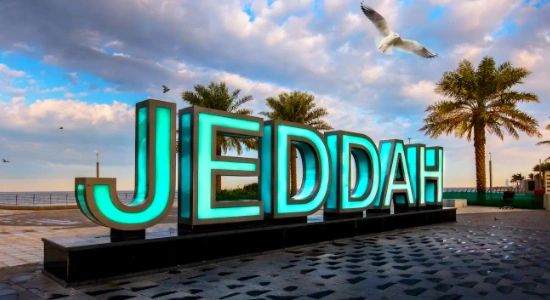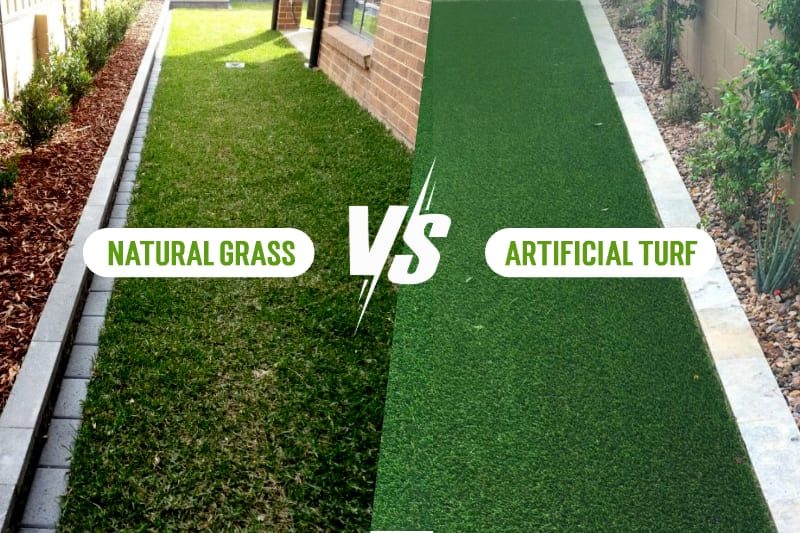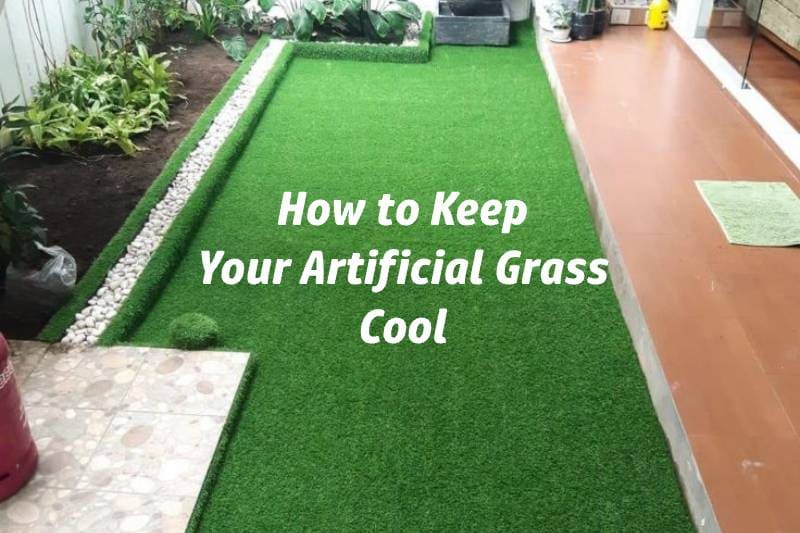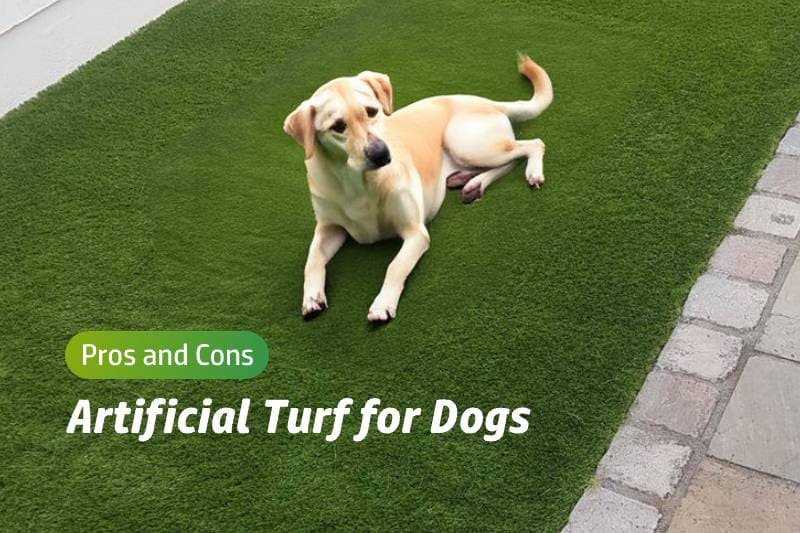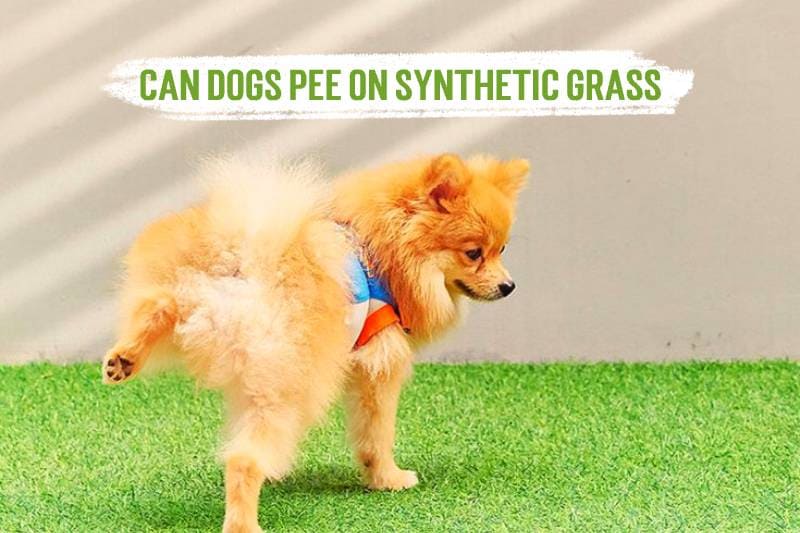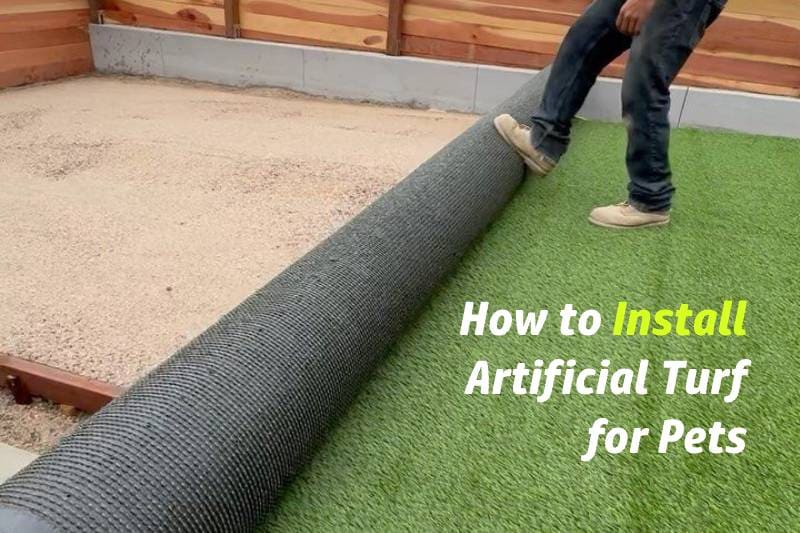Installing artificial grass on concrete begins with thoroughly assessing and preparing the surface. First, inspect the concrete for cracks, bumps, or painted areas and clean it using a stiff broom and garden hose to ensure a smooth, debris-free foundation. Address any imperfections with leveling compounds or repair work to guarantee proper drainage and adhesion. Accurate measurements and selecting quality synthetic turf along with a foam underlay set the stage for a durable, attractive green area.
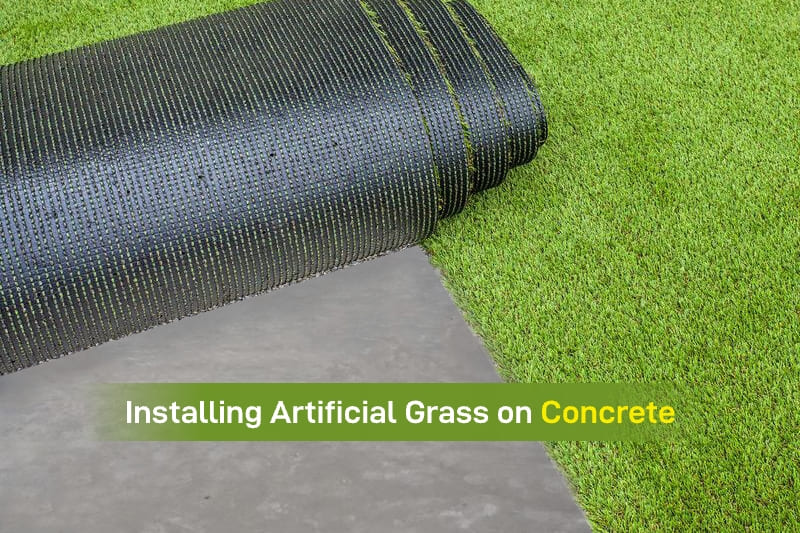
Once the surface is prepped, the installation continues with carefully laying the turf. The grass is trimmed to fit with a sharp knife and secured using adhesive tape or glue along edges and seams to prevent movement. Sand infill is applied evenly, helping the blades stand upright and enhancing durability. Regular brushing, cleaning, and periodic maintenance—addressing loose seams and managing weeds—ensure the artificial grass remains vibrant, functional, and long-lasting.
Can You Put Fake Grass on Concrete?
Want to make your concrete area green? You can put fake grass on it. It’s a great way to make your outdoor space nicer. Let’s see how you can do this.
Check Your Concrete
First, look at your concrete. Are there cracks or bumps? These can make the grass not sit right. Fix them first. A smooth surface helps the grass look good and last long.
Getting Ready for Painted or Sloped Concrete
Is your concrete painted or sloped? No problem. You can still add fake grass. For painted spots, take off loose paint. This helps the grass stick better. On sloped areas, use extra support to stop the grass from moving. Glue or tight edges can help keep it in place.
Fake grass on concrete is strong and easy to care for. It makes hard places soft and safe for kids and pets. It looks nice all year. With some work, you can have a pretty green spot.
Benefits of Putting Fake Grass on Concrete
When I put fake grass on concrete, I found many good things. Let me tell you about them.
Strong and Lasts Long
Fake grass is very strong. It doesn’t wear out like real grass. The fake grass is made from tough stuff. It can handle bad weather. My fake grass on concrete lasted longer than other things. It didn’t fade or break from sun or rain. This means I don’t need to change it often. It saves me time and money.
Easy to Care for and Safe
Having fake grass on concrete is easy. I don’t need to mow or water it. The grass stays green without work. It’s also safe for kids and pets. The surface is soft, so it’s safer for play. It doesn’t bring bugs like real grass. This makes my outdoor space clean and safe for my family.
Looks Nice and Can Be Used Anywhere
Fake grass on concrete looks pretty. It looks like real grass and makes my home look nice. It stays bright all year, no matter the season. It’s also useful. I can use it in many places, like patios or balconies. It works in shady spots where real grass can’t grow. This lets me be creative with my outdoor space.
Tools and Materials Needed
When I put artificial grass on concrete, having the right stuff helped a lot. Here’s what you need to start.
Important Tools
To make things easy, you’ll need some tools. Here’s what I used:
- Stiff Broom: This cleans the concrete well before you lay the grass.
- Garden Hose: Use this to wash away dust and dirt from the concrete.
- Stanley Knife: A sharp knife is needed to cut the grass to fit. Keep extra blades ready.
- Filling Knife or Striping Knife: These spread glue evenly on the surface.
- Staple Gun: If using staples, this tool is needed. Or use a hammer and nails, but be careful of sharp parts.
Having these tools ready saves time and makes the job neat.
Needed Materials
Now, let’s talk about the materials. They are as important as the tools:
- Artificial Grass: Pick good turf for your needs, like a sports field or patio.
- Adhesive: This sticks the grass to the concrete. Make sure it’s good for outside and can handle weather.
- Foam Underlay: Use this for comfort and better drainage. It also helps with small bumps on the concrete.
- Sand Infill: This keeps the grass blades up and adds weight to stop moving.
With these materials, you can turn your concrete into a green area. Remember, getting ready is key to doing it well.
Preparing the Concrete Surface
Before I install artificial grass on concrete, I make sure the surface is ready. This step is crucial for a smooth and long-lasting finish. Let me walk you through how I prepare the area.
Assessing the Condition of the Concrete
First, I take a good look at the concrete. I check for cracks, bumps, or any uneven spots. These can cause problems later. If I find any cracks, I fill them in. For bumps, I use a grinder to level them out. A smooth surface is key for a successful artificial turf installation on concrete.
Cleaning and Leveling the Surface
Next, I clean and prepare the surface. I grab a stiff broom and sweep away dirt and debris. Then, I use a garden hose to wash the area thoroughly. This removes any dust that might prevent the grass from sticking well. After cleaning, I make sure the surface is level. If there are any low spots, I fill them with a leveling compound. This step ensures the artificial grass on concrete will lay flat and look great.
Ensuring Proper Drainage
Finally, I focus on drainage. Good drainage prevents water from pooling under the grass. I check the slope of the concrete. If needed, I adjust it to allow water to flow away. Sometimes, I install a drainage mat under the grass. This helps water move through and keeps the area dry. Proper drainage is essential for maintaining the grass and preventing damage.
By following these steps, I ensure the concrete is ready for the next phase. Preparing the area well makes the installation process smoother and the results more satisfying.
Picking and Measuring Fake Grass
When I wanted fake grass on concrete, picking the right kind and measuring it right were key steps. These choices can change how your green space looks and feels.
Picking the Best Grass
Picking fake grass means thinking about a few things. First, think about how you’ll use the area. If it’s just to look nice, you might not need the softest grass. But if kids or pets will play there, comfort is important. I found that adding foam under the grass makes it softer and better for playing.
Fake grass comes in different textures and colors. I picked one that looked like real grass, with mixed green shades and a real feel. This made my outdoor space look bright and welcoming. Also, think about how strong the grass is. Good quality grass can handle weather and lots of walking, so it lasts long.
Measuring Right
Measuring right is super important when putting fake grass on concrete. I started by measuring the whole area where I wanted the grass. Using a tape measure, I checked the length and width, making sure to include any odd shapes or corners.
To avoid wasting grass, I added a few extra inches to my measurements. This extra bit helped me fit the grass during setup without running out. When cutting the grass, I used a sharp knife for neat edges. This made sure the pieces fit well together, giving a smooth look.
Before putting down the base, I checked my measurements again. This step stopped mistakes and made the setup easy. By getting the area ready and measuring right, I made my concrete look like a green, lush place.
Step-by-Step Guide to Install Artificial Grass on Concrete
Transforming your concrete space into a lush green area is easier than you might think. Here’s my step-by-step guide to help you properly install artificial grass on concrete.
Installing Drainage Solutions
First, I focus on drainage. Good drainage is crucial for artificial turf installation on concrete. Without it, water can pool and damage the grass. I start by laying a drainage mat over the concrete. This mat allows water to flow through and away from the surface. If the area has a slope, I make sure the mat follows the slope to guide water off the surface. This step ensures that the grass stays dry and lasts longer.
Applying Foam Underlay
Next, I add a foam underlay. This layer makes the surface soft and comfortable. It also helps with drainage and covers any small bumps on the concrete. I roll out the foam underlay over the drainage mat. Then, I cut it to fit the area using a sharp knife. I make sure the pieces fit snugly together without gaps. This step is important for a smooth and even surface when I install artificial grass.
Laying and Securing the Grass
Now comes the exciting part—installing the lawn. I unroll the artificial grass over the foam underlay. I take my time to align the edges and make sure the grass covers the entire area. Using a Stanley knife, I trim the edges for a perfect fit. To secure the grass, I use adhesive tape or glue along the edges and seams. This keeps the grass in place and prevents it from moving. I press down firmly to ensure a strong bond. This step completes the artificial grass installation and gives the area a fresh, green look.
By following this DIY guide, you can install artificial turf that is both cheap and easy to install. With these steps, you can enjoy a beautiful and low-maintenance green space on your concrete.
Applying Sand Infill
After laying the artificial grass on concrete, I move on to applying sand infill. This step is crucial for maintaining the grass’s appearance and functionality. The sand infill helps keep the grass blades upright, providing a natural look and feel. It also adds weight to the grass, preventing it from shifting or moving.
- Choosing the Right Sand: I start by selecting the right type of sand. Silica sand is a popular choice because it’s clean and doesn’t compact easily. It ensures the grass remains soft and comfortable underfoot. I avoid using beach sand as it can contain impurities that might harm the grass.
- Spreading the Sand: I use a spreader to evenly distribute the sand across the surface. This tool helps me cover large areas quickly and ensures an even layer. I aim for a thin layer, about half an inch deep, to provide adequate support without overwhelming the grass.
- Brushing the Grass: After spreading the sand, I grab a stiff broom and brush the grass. This action helps the sand settle between the blades and keeps them standing tall. I brush in different directions to ensure the sand reaches all areas and the grass looks lush and full.
- Checking the Coverage: Finally, I check the coverage to make sure the sand is evenly distributed. If I notice any low spots, I add more sand and brush again. This step ensures the grass remains stable and looks great over time.
By following this step-by-step guide, I ensure the artificial grass installation on concrete is both durable and visually appealing. The sand infill plays a vital role in maintaining the grass’s integrity and enhancing its overall appearance.
Securing the Synthetic Grass on Concrete
Securing synthetic grass on concrete is a crucial step in ensuring that your new green space remains beautiful and functional. I found that using the right techniques and materials makes a big difference in the final result. Let me share how I do it.
Using Adhesive Tape or Glue
To secure the grass effectively, I use adhesive tape or glue. These materials help keep the grass in place, preventing it from shifting or lifting over time. Here’s how I do it:
- Choose the Right Adhesive: I select an adhesive that is suitable for outdoor use. It needs to withstand weather changes and provide a strong bond. I often use a high-quality glue designed specifically for artificial grass.
- Apply the Adhesive: I start by laying the adhesive tape along the edges of the concrete surface. If I use glue, I apply it in a zigzag pattern to cover more area. This ensures that the grass sticks well and stays secure.
- Press Firmly: After placing the grass over the adhesive, I press down firmly. This step is important to ensure a strong bond between the grass and the concrete. I pay extra attention to the edges and seams to prevent any lifting.
Using adhesive tape or glue helps me secure the grass effectively, providing a stable and long-lasting installation.
Stretching and Securing the Turf
Stretching the turf properly is essential for a smooth and wrinkle-free finish. Here’s how I make sure the turf looks perfect:
- Align the Grass: I start by aligning the grass with the edges of the concrete. This helps me ensure that the grass covers the entire area evenly.
- Stretch the Turf: I gently pull the turf to remove any wrinkles or folds. Stretching the turf helps it lay flat and look natural. I work from one end to the other, making sure the grass is taut.
- Secure the Edges: Once the turf is stretched, I secure the edges using adhesive tape or glue. This step prevents the grass from moving and keeps it in place. I make sure the edges are tightly secured to avoid any gaps.
- Check for Wrinkles: Finally, I check the entire surface for any remaining wrinkles. If I find any, I adjust the turf and press down again to ensure a smooth finish.
By following these steps, I can install artificial grass on concrete that looks great and stays in place. Securing the grass properly enhances its appearance and ensures it remains durable over time.
Final Touches and Maintenance Tips
After putting artificial grass on concrete, I make sure it looks good and stays nice. These steps help the grass stay great for a long time.
Brushing and Settling the Grass
When the grass is down, I use a stiff broom to brush it. This makes the grass blades stand up straight, so it looks real. Brushing also helps the sand fill in between the blades, keeping them steady. I brush in different ways to spread the sand evenly and make the grass fluffy. This simple task really improves how the lawn looks.
I also check the edges and seams. Pressing them down hard keeps them from lifting later. If any spots need more help, I add a bit more glue to hold them down. Paying attention to these details helps the grass settle well and look better.
Regular Maintenance Practices
Taking care of artificial grass is easy and doesn’t take much work. Here are some things I do to keep my green area looking great:
- Regular Brushing: I brush the grass every few weeks to keep it standing tall and clean. This keeps it looking lush and stops it from getting flat.
- Cleaning: I use a garden hose to wash the grass sometimes. This gets rid of dust and dirt, keeping it fresh. For tough stains, a little soap and water work well.
- Checking for Damage: I look at the grass often for any problems. If I see loose edges or seams, I add more glue to fix them. This stops small problems from getting worse.
- Weed Control: Weeds don’t usually grow in artificial grass, but I watch for any around the edges. A quick spray of weedkiller takes care of them.
By doing these things, I keep my artificial grass on concrete looking beautiful and useful. The grass stays bright and welcoming, making a perfect place to relax and play.
FAQ
Can I put fake grass on any concrete?
Yes, you can put fake grass on most concrete, even paving stones. It turns boring spots into green areas. Make sure the surface is clean and flat first.
How do I make sure water drains well?
Good drainage stops water from pooling. Use a drainage mat under the grass. This lets water flow away, keeping your grass dry.
What are the good things about fake grass on concrete?
Fake grass is easy to care for, strong, and looks nice. It’s safe for kids and pets to play on. It also makes your home look better from the street.
Do I need special tools to put down fake grass?
You don’t need many special tools. A stiff broom, garden hose, sharp knife, and glue are important. These help you clean, cut, and stick the grass down.
How do I pick the right fake grass?
Think about how you’ll use the space. For play, choose soft grass with foam for comfort. Look for grass with mixed greens for a real look. Pick strong grass that lasts.
Can I put fake grass on sloped concrete?
Yes, you can put fake grass on sloped concrete. Use extra glue or tight edges to keep it from moving. This helps it stay in place and look good.
How do I take care of fake grass on concrete?
Taking care is easy. Brush the grass to keep it standing up. Use a hose to wash away dirt. Check for damage and fix loose edges with glue. This keeps it looking fresh.
Is fake grass safe for kids and pets?
Yes! Fake grass is soft and safe for kids and pets. It doesn’t attract bugs like real grass, so it’s cleaner for your family.
Can fake grass make my home look nicer?
Yes, putting fake grass can make your home look much nicer. It adds a bright and friendly look to outdoor spaces.




